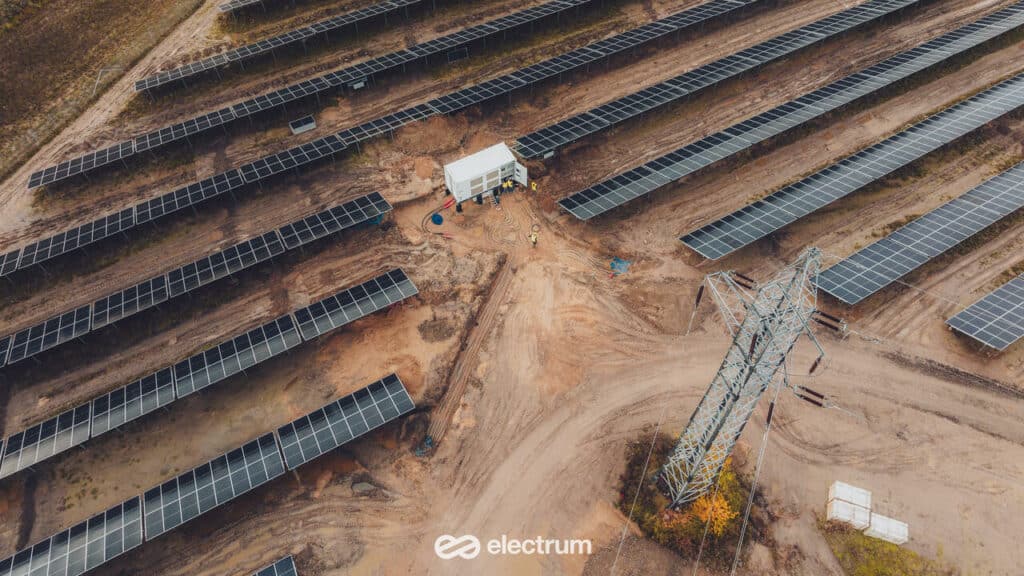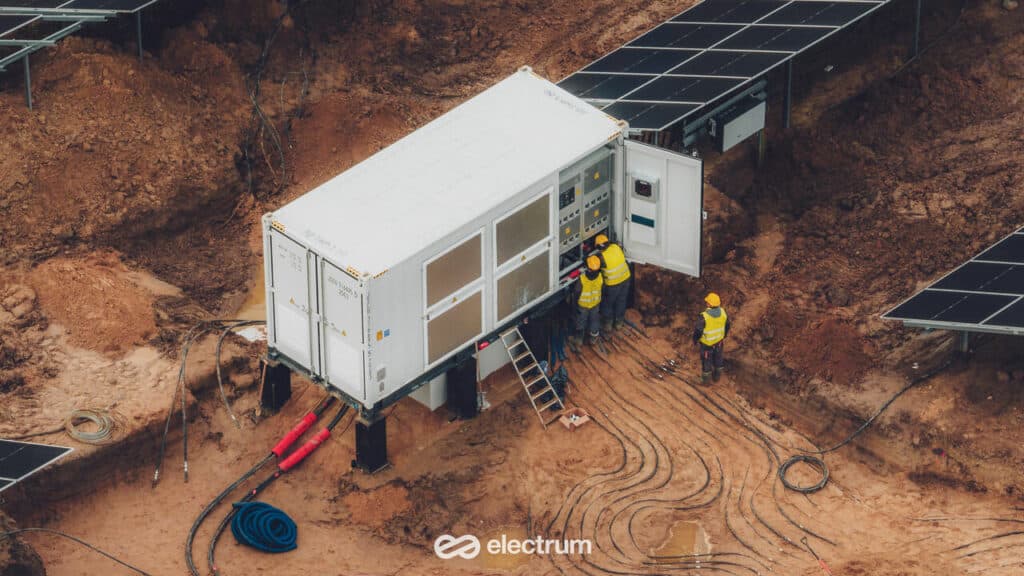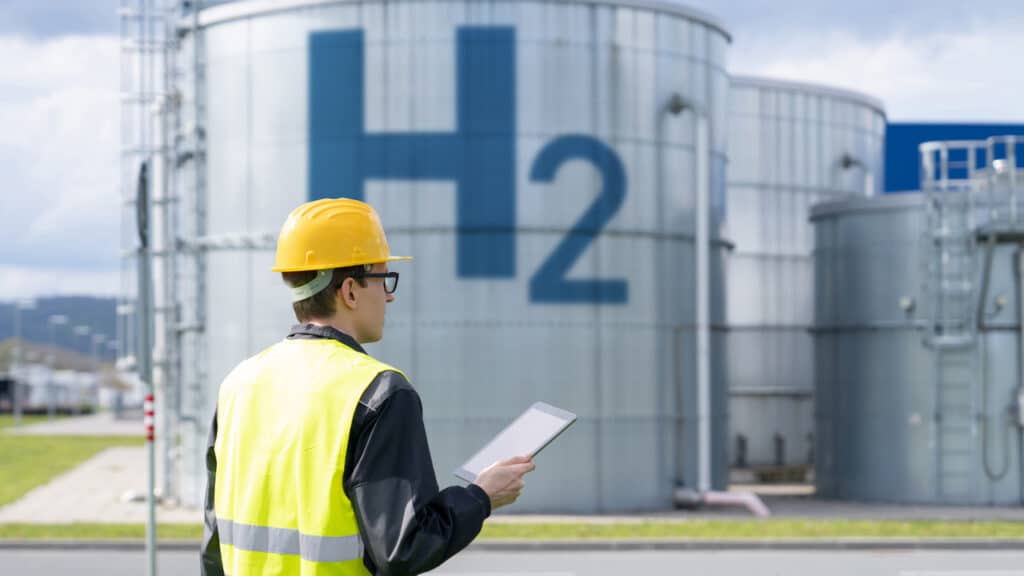Different methods of energy storage in the renewable energy sector provide a balance between energy production and its utilization. They ensure a constant supply of energy to consumers and increase the flexibility of energy systems. In today’s article, we will present the methods of energy storage and what you should know about them.
Methods of Energy Storage
Among the methods of energy storage, we distinguish:
- Chemical
- Electrical
- Thermal
- Mechanical

Chemical Energy Storage
The electrochemical storage method involves using batteries to store energy in chemical form. The conversion of electrical energy into chemical compounds is the basis of one of the most popular energy storage technologies. Chemical energy storages mainly include batteries:
- Low-temperature – lead-acid or lithium-ion
- High-temperature mainly sodium-sulfur (so-called systems with internal storage – their energy level and output power are independent)
- Systems with external energy storage – hydrogen/methane and flow batteries (redox-flow batteries).
Types of Energy Storages
Battery Storages
Electrochemical energy storages use chemical processes to store electrical energy. They are otherwise simply called batteries or accumulators. The most popular batteries for storing energy from renewable sources are:
- Lithium-ion batteries for energy storage – characterized by high energy density, low weight, cycle stability, and long life. Due to their ability to quickly charge and discharge, they are ideal for managing peak loads. Lithium-ion energy storage can perfectly serve as a backup source in the industry and in photovoltaic and wind systems.
Lithium-ion energy storage on RES farms
Lithium-ion batteries are popular in storing electrical energy in renewable energy installations. On photovoltaic farms, batteries are usually placed in specially designed containers (so-called container energy storages) or buildings near photovoltaic panels.

Lithium iron phosphate batteries
Lithium iron phosphate batteries are considered one of the safest types of lithium-ion batteries. They have high tolerance to high temperatures, reducing the risk of safety issues such as overheating or ignition.
Lead-acid batteries
Lead-acid batteries are the most widespread. These energy storages are characterized by useful power and energy densities with low self-discharge, making them suitable as starter batteries or UPS emergency power supplies, for example in telecommunications. It is worth mentioning that the energy storage system can provide the possibility of compensating for short- and medium-term load changes.
High-temperature batteries
Popular types of high-temperature storages include those based on sodium sulfide (NaS) and sodium chloride and nickel (so-called ZEBRA batteries). Here, the active material is liquid electrolyte, which distinguishes the storages from low-temperature ones. They also require operation at a temperature of about 300°C, a large number of charge/discharge cycles, and high efficiency.
Flow batteries
Flow storages store energy in the form of electrolyte in tanks. They are more scalable than traditional batteries and can store larger amounts of energy, making them suitable for large-scale electricity storage.
Redox-flow batteries
They belong to the group of external chemical storages. Their features include an active material based on salts dissolved in a liquid electrolyte in a separate tank. Another type of flow battery is the vanadium redox-flow battery, a type of energy storage that stores energy in chemical form in electrolyte solutions.
It should be noted that vanadium resources are limited, which affects the economic exploitation. The advantage over internal chemical storage systems is the independence of selecting the power and capacity of the battery.
Hydrogen/Methane
Another way of energy storage is hydrogen, which can be compressed to a significant degree in salt caverns, determining low reservoir costs and high energy storage capacity.

- Fuel cells – Convert chemical energy contained in fuel (e.g., hydrogen) directly into electrical energy through chemical reactions. They are efficient and clean since their only byproduct is water.
- Hydrogen or methane creation – These processes can be used to store electrical energy in chemical form. For example, hydrogenation involves using excess electrical energy to electrolyze water, resulting in hydrogen. It can later be used to power fuel cells or to produce methane, which is easy to store and transport.
Green Hydrogen on Solar and Wind Farms

When planning systems to compensate for the power fluctuations of solar farms, the flammability of hydrogen should be considered. Therefore, green hydrogen is methanated by supplying CO2 (Fischer-Tropsch process). As a result, clean methane is obtained, which is easy to operate and control for safety. The costs of energy storages based on methane are lower.
Electrical Energy Storage Systems
Electrical energy storage technologies usually do not require secondary material for its storage. Storage often occurs in an electrostatic field or a constant magnetic field. These systems can quickly charge and discharge. Two examples are worth discussing here: supercapacitors and superconducting coils.
Supercapacitors
Supercapacitors can be used for short-term energy storage, for example, to balance temporary changes in the production of energy from photovoltaic or wind farms. Due to their ability to quickly charge and discharge, they can deliver energy in short cycles.
Superconducting magnetic energy storage (SMES)
Stores energy in the form of a magnetic field generated by direct current flowing through a coil. For lossless energy storage, cooling the coil with liquid helium is required.
Thermal Energy Storage
Thermal storage focuses on heat accumulation that can be used later, for example, to heat buildings or in industrial processes. Energy storage technologies, such as thermal accumulators, use various media like water, stones, or salts to effectively store heat.
These power storage systems are particularly efficient when combined with solar energy, allowing the use of excess heat during periods when solar collectors do not generate energy.
Mechanical Energy Storages
Mechanical energy storage methods, such as hydroelectric power plants or flywheels, store energy through physical processes.
For example, pumped-storage hydroelectric plants store energy by pumping water to a higher-level reservoir, later using it to generate energy through turbines. Flywheels store kinetic energy in a rotating disk, which can quickly release the stored energy to stabilize the grid and respond to sudden changes in demand.

Pumped-Storage Power Plant
The kinetic energy of water flowing from the upper reservoir to the lower one is converted into electrical energy in a generator. This is a widespread energy storage system, accounting for 99% of global energy storage systems in power grids. Unlike battery systems, the possible locations of such units depend on geographical conditions and are usually located far from energy consumption centers. Economically, pumped-storage power plants are one of the most cost-effective options for electrical energy storage.
Flywheel Energy Storages
Energy storage is also possible by using kinetic energy in rotational motion. Suspended in a vacuum on magnetic bearings, the flywheel stores energy. This type of energy storage is characterized by high durability and high power density. Units focus mainly on reducing short-term voltage and frequency fluctuations to improve energy quality.
Compressed Air Energy Storage (CAES)
Another type of energy storage – compressed air energy storage (CAES) – uses compressed air as an energy carrier stored, for example, in salt caverns. The development of adiabatic compressed air energy storage systems has progressed with the increase in the use of energy from renewable sources. The principle of operation of a storage system based on compressed air is analogous to that of a pumped-storage power plant. The choice of installation location depends primarily on the availability of underground reservoirs where compressed air can be stored.
Magnetic Energy Storage
Uses a magnetic field to store energy in the form of the potential energy of magnets. Magnetic storages are highly efficient, quickly charge and discharge, and have a long lifespan.
Energy Storage from Photovoltaic Panels

Various energy storage technologies allow them to be adapted to the needs of each renewable energy investment. Below we present the most popular solutions used to store solar energy:
- Energy storage batteries – The most common way to store electrical energy produced by photovoltaic panels is batteries. Typical types of batteries used to store energy from photovoltaics are lithium-ion batteries, which are efficient, have a long lifespan, and are easy to manage.
- Hybrid systems – Storing energy from photovoltaic panels can include the use of hybrid systems. They combine photovoltaic panels with other energy sources such as wind or water turbines. Integrated hybrid systems can offer greater energy independence and can be more efficient in areas where weather conditions dynamically change.
- Flow technologies – Flow storages are another technology used to store energy from PV panels. Flow storages are scalable and can store larger amounts of energy compared to traditional batteries.
- Energy management and smart grids – With the development of energy management technologies and smart grids, storing energy from photovoltaic panels is becoming more advanced. Intelligent energy management systems can optimize the charging and discharging time of batteries depending on weather conditions, energy prices, and individual user needs.
Read also: How does a photovoltaic installation with energy storage work?
Energy Storage from Wind Power

- Lithium-ion batteries – Are widely used to store excess energy during periods when the wind blows strongly, and energy production is high. They can later release the stored energy when the wind weakens or during periods of increased demand.
- Flow storages – Also known as flow batteries, store energy in the form of electrolyte, allowing easy adjustment of storage capacity to the requirements of wind energy production.
- Thermal storages – Wind energy can be used to generate heat stored in thermal substances such as water or stones. This can be used to heat buildings or to produce electricity through a steam turbine.
- Hydrogen electrolysis – Wind can be used for water electrolysis, producing hydrogen, which is then stored and used to power fuel cells or produce synthetic fuels.
Energy Storage Method – How to Choose the Best One?
Different types of energy storages provide a wide range of uses. The choice of the most optimal storage method depends on factors such as the characteristics of renewable energy production, energy consumption profile, financial requirements, as well as local environmental conditions. When considering different options, it is crucial to understand that each has its unique properties, which may better address specific challenges and needs of a given area or project.

At Electrum, we offer solutions tailored to the specific conditions of each renewable energy installation. Our goal is always to manage energy resources efficiently and economically.
Hybrid Installation and Energy Storages
A pioneering project by Electrum, implemented under the MESH4U initiative, is the development of a hybrid energy storage system that combines various technologies – from electrochemical to thermal and mechanical.
This multifunctional storage hub not only provides flexibility in managing energy resources for industry and households but also enables technical and economic optimization. Through a holistic approach, the system increases the efficiency of renewable energy utilization and supports the transition towards a low-emission economy.
The Future of Energy Storage
Modern energy storages, called the energy storages of the future, are in an intensive development phase. If you want to know more about this topic, read: How Energy Storages Are Revolutionizing the Renewable Energy Market?
Energy Storage and Monitoring

In effective energy storage, it is essential not only how we store the energy but also how we monitor the process. Our innovative EMACS (Everything Monitoring and Control System) solution combines the advantages of the classical SCADA (Supervisory Control and Data Acquisition) system with advanced business analysis functions, creating the first and only such multifunctional platform on the Polish market.
Key benefits of implementing the EMACS system include:
- Significant reduction in operational costs through continuous monitoring of the facility’s infrastructure
- Immediate response to malfunctions, often allowing remote resolution
- Improvement of technological processes through automation and utilization of the installation’s maximum capabilities at any given moment
- Effective monitoring of energy production, consumption, storage, and distribution, allowing precise determination of the energy balance of industrial installations.
Types of Energy Storages – Summary
In this article, we presented various methods of energy storage and types of storages that are an indispensable element of the effective utilization of renewable energy sources. From electrochemical systems, through thermal, to mechanical – each of these technologies has its place in the energy ecosystem, offering specific benefits and opportunities.








